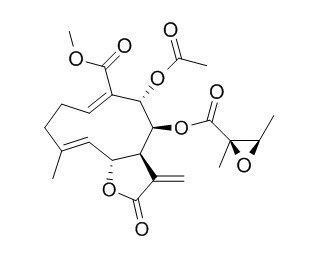Uvedalin
Uvedalin shows cytotoxicity against HeLa, HL-60, and Murine B16-F10 melanoma cell lines.
Inquire / Order:
manager@chemfaces.com
Technical Inquiries:
service@chemfaces.com
Tel:
+86-27-84237783
Fax:
+86-27-84254680
Address:
1 Building, No. 83, CheCheng Rd., Wuhan Economic and Technological Development Zone, Wuhan, Hubei 430056, PRC
Providing storage is as stated on the product vial and the vial is kept tightly sealed, the product can be stored for up to
24 months(2-8C).
Wherever possible, you should prepare and use solutions on the same day. However, if you need to make up stock solutions in advance, we recommend that you store the solution as aliquots in tightly sealed vials at -20C. Generally, these will be useable for up to two weeks. Before use, and prior to opening the vial we recommend that you allow your product to equilibrate to room temperature for at least 1 hour.
Need more advice on solubility, usage and handling? Please email to: service@chemfaces.com
The packaging of the product may have turned upside down during transportation, resulting in the natural compounds adhering to the neck or cap of the vial. take the vial out of its packaging and gently shake to let the compounds fall to the bottom of the vial. for liquid products, centrifuge at 200-500 RPM to gather the liquid at the bottom of the vial. try to avoid loss or contamination during handling.
Korean Journal of Pharmacognosy2018, 49(3):270-277
Tissue Cell.2022, 75:101728.
The Thai Journal of Pharmaceutical Sciences2023, 47(3):3.
J Appl Biol Chem.2021, 64(3),263?268
J. Pharm. Res. Int.2022, 34(58): pp.1-14.
JPC-Journal of Planar Chromatography 2017, 30(4)
J Pharm Biomed Anal.2017, 140:274-280
Plos One.2020, 10.1371
J Pharm Biomed Anal2016, 118:183-194
Molecules.2017, 22(2)
Related and Featured Products
Zygote. 2015 Jun;23(3):406-11.
Effect of different types of sesquiterpene lactones on the maturation of Rhinella arenarum oocytes.[Pubmed:
24522008]
The sesquiterpene lactones (STLs) are a large class of plant secondary metabolites that are generally found in the Asteraceae family and that have high diversity with respect to chemical structure as well as biological activity. STLs have been classified into different groups, such as guaianolides, germacranolides, and melampolides etc., based on their carboxylic skeleton. In amphibians, fully grown ovarian oocytes are arrested at the beginning of meiosis I. Under the stimulus of progesterone, this meiotic arrest is released and meiosis progresses to metaphase II, a process known as oocyte maturation. The purpose of this work was to determine whether sesquiterpene lactones from the germacranolide and melampolide groups act as inhibitor agents on the meiosis of amphibian oocytes in vitro.
METHODS AND RESULTS:
Results for germacranolides indicated that the addition of deoxyelephantopins caused a high degree of inhibition and that minimolide showed a moderate inhibitory effect, whereas glaucolide A was inactive. Furthermore, the addition of melampolides (Uvedalin, enhydrin, polymatin A and polymatin B) showed inhibitory effects. For enhydrin and Uvedalin, inhibitory effects were observed at the higher concentrations assayed. The results of this study suggest that the inhibitory activity of the tested sesquiterpene lactones on the meiosis of Rhinella arenarum oocytes is not dependent on the group to which they belong, i.e. not on the carboxylic skeleton, but probably due to the arrangement and type of function groups present in the molecules.
CONCLUSIONS:
All assayed lactones in the germacranolide group showed low toxicity. In contrast, important differences in toxicity were observed for lactones from the melampolide group: enhydrin and Uvedalin showed low toxicity, but polymatin A and B were highly toxic.
Evid Based Complement Alternat Med. 2013;2013:627898.
Trypanocidal Activity of Smallanthus sonchifolius: Identification of Active Sesquiterpene Lactones by Bioassay-Guided Fractionation.[Pubmed:
23840260]
METHODS AND RESULTS:
In order to find novel plant-derived biologically active compounds against Trypanosoma cruzi, we isolated, from the organic extract of Smallanthus sonchifolius, the sesquiterpene lactones enhydrin (1), Uvedalin (2), and polymatin B (3) by bioassay-guided fractionation technique. These compounds showed a significant trypanocidal activity against the epimastigote forms of the parasite with IC50 values of 0.84 μ M (1), 1.09 μ M (2), and 4.90 μ M (3). After a 24 h treatment with 10 μ g/mL of enhydrin or Uvedalin, parasites were not able to recover their replication rate. Compounds 1 and 2 showed IC50 values of 33.4 μ M and 25.0 μ M against T. cruzi trypomastigotes, while polymatin B was not active. When the three compounds were tested against the intracellular forms of T. cruzi, they were able to inhibit the amastigote replication with IC50 of 5.17 μ M, 3.34 μ M, and 9.02 μ M for 1, 2, and 3, respectively. The cytotoxicity of the compounds was evaluated in Vero cells obtaining CC50 values of 46.5 μ M (1), 46.8 μ M (2), and 147.3 μ M (3) and the selectivity index calculated.
CONCLUSIONS:
According to these results, enhydrin and Uvedalin might have potentials as agents against Chagas disease and could serve as lead molecules to develop new drugs.
J Agric Food Chem. 2015 Dec 23;63(50):10856-61.
New Sesquiterpene Lactone Dimer, Uvedafolin, Extracted from Eight Yacon Leaf Varieties (Smallanthus sonchifolius): Cytotoxicity in HeLa, HL-60, and Murine B16-F10 Melanoma Cell Lines.[Pubmed:
26576855 ]
Uvedafolin, 1, a new sesquiterpene lactone dimer, was isolated from the leaves of Smallanthus sonchifolius with five related compounds, 2-6, and their cytotoxicity was assessed against three tumor cell lines (HeLa, HL-60, B16-F10 melanoma).
METHODS AND RESULTS:
The stereostructure of 1 was newly elucidated by ESI-TOF-MS, 1D/2D NMR, and single-crystal X-ray diffraction. Dimers 1 and 2 had the most effective IC50 values, 0.2-1.9 μM, against the three tumor cell lines when compared with monomers 3-6 (IC50 values 0.7-9.9 μM) and etoposide (IC50 values 0.8-114 μM). The ester linkages of two sets of monomers, Uvedalin, 5, and sonchifolin, 6, for 1, and enhydrin, 4, and sonchifolin, 6, for 2, as well as the acetyl group at the C-9 position, were essential for the high cytotoxicity. Dimers 1 and 2 would have potential as anticancer agents.



